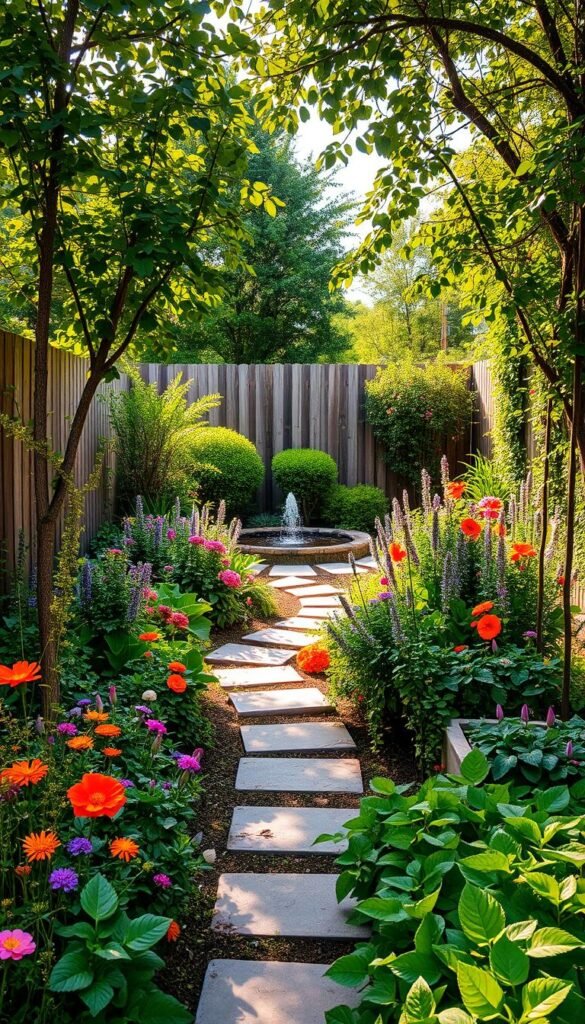Living in the city doesn’t mean sacrificing greenery. With smart layout strategies, even the tiniest balcony or patio can bloom into a refreshing escape. Vertical growing solutions and multi-functional furniture turn cramped areas into inviting nooks perfect for morning coffee or evening relaxation.
Compact spaces offer surprising benefits. You’ll find that dwarf plant varieties and creative container arrangements let you cultivate vibrant displays without clutter. Portable planters on wheels adapt to changing sunlight, while raised beds protect roots from pavement heat.
Don’t let challenges like limited soil depth deter you. Resilient plants like sedum or fountain grass thrive in urban conditions, as detailed in this guide to low-maintenance greenery. Pair them with strategic lighting, and your corner of nature becomes a calming sanctuary year-round.
Investing time in your outdoor area pays dividends beyond beauty. A well-designed space boosts property appeal while offering a sustainable hobby that reconnects you with nature’s rhythms—right outside your door.
Getting Started with Your Small Garden
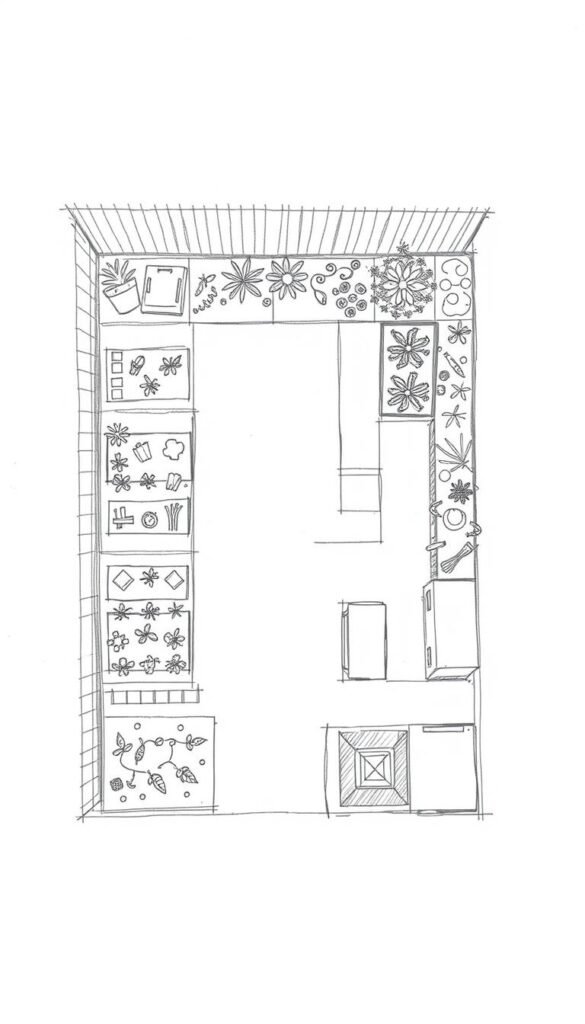
Your journey begins by understanding what you truly want from your personal green zone. Before choosing plants or decor, grab a notebook and sketchpad – this is where your vision takes shape.
Assessing Your Outdoor Space
Start with precise measurements of your available ground and vertical surfaces. Track sunlight patterns over three days using your phone’s notes app. Observe how existing walls or fences create microclimates – that shaded corner might perfect for ferns!
Defining Your Garden Priorities
Create a must-have list using this simple ranking method:
- Daily essentials (herb gardens, seating)
- Seasonal features (flower displays, holiday decor space)
- Future expansion ideas
If you’re torn between a grill station and play area, ask: “Which will we use most evenings?” Remember, transforming concrete spaces works best when functionality meets joy. Document your plans with quick phone snaps – sometimes seeing it framed helps spot layout improvements.
Understanding Urban Gardening Challenges
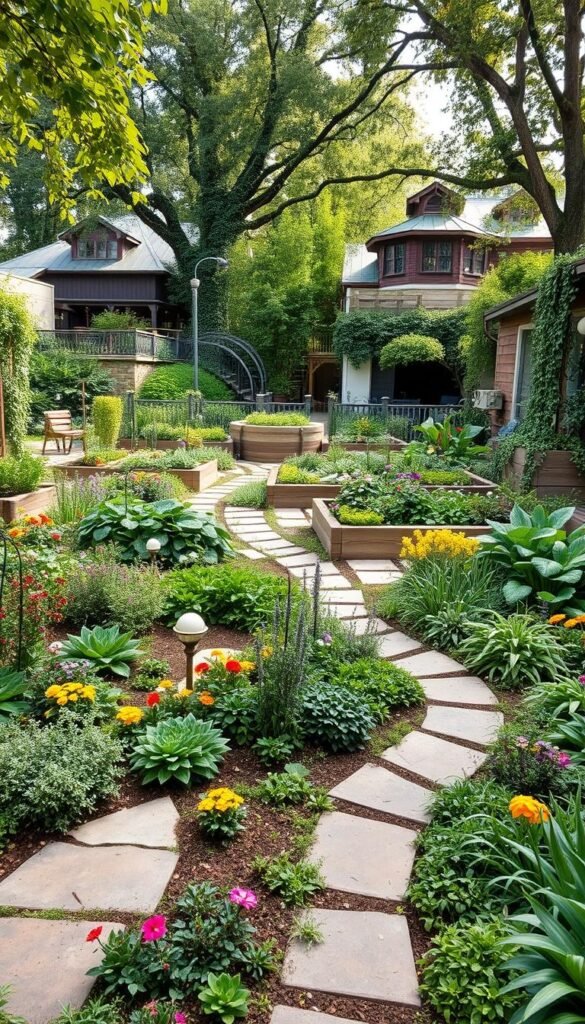
Urban environments present unique hurdles for green spaces, but clever planning can turn constraints into opportunities. Limited square footage demands smart strategies to balance beauty and practicality. Let’s explore how to transform tight quarters into thriving green retreats.
Space Limitations and Creative Layouts
Working with a compact yard means reimagining traditional gardening methods. Sunlight often plays hide-and-seek between buildings, while concrete surfaces radiate heat. Test your soil early—many city plots need amendments due to past construction or pollution.
Smart layouts prioritize movement and function. Map foot traffic patterns to avoid cramped pathways. A well-designed seating nook might double as a herb garden ledge, maximizing every inch.
| Challenge | Solution | Benefit |
|---|---|---|
| Shallow soil depth | Raised beds with quality mix | Healthier root systems |
| Limited sunlight | Reflective surfaces & shade plants | Year-round greenery |
| Narrow walkways | Vertical planters on walls | Unobstructed movement |
Wind tunnels between buildings? Try sturdy grasses like blue fescue. They sway beautifully while protecting delicate blooms. Remember, your backyard’s microclimates create distinct growing zones—track them like a weather detective!
Containers offer flexibility when redesigning your area. Roll them into sun patches or cluster them for visual impact. With thoughtful design, even a postage-stamp yard becomes a personalized oasis.
Choosing the Right Design Elements
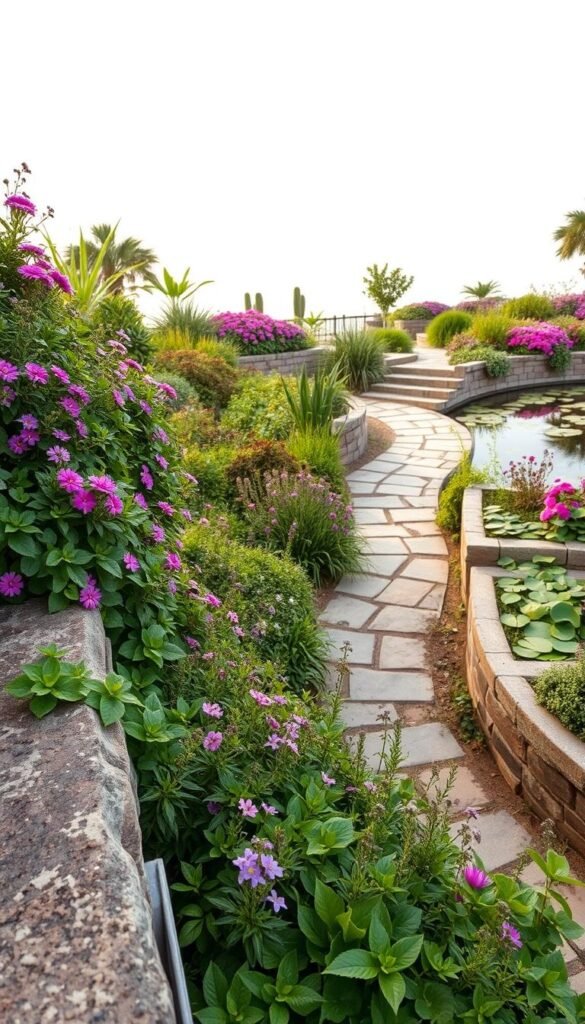
The secret to a stunning urban retreat lies in thoughtful design choices that marry form and function. Start by visualizing how your greenery interacts with built structures – a sleek metal planter might enhance modern architecture, while terracotta pots add rustic warmth to traditional settings.
Selecting Plants and Materials
Match your botanical picks to your home’s personality. A minimalist concrete patio shines with sculptural succulents, while cottage-style railings beg for trailing ivy. Consider these factors:
- Mature plant dimensions (avoid species that outgrow your area)
- Seasonal color shifts (evergreen vs. flowering varieties)
- Material durability (weather-resistant ceramics vs. lightweight resins)
A dwarf Japanese maple makes an elegant focal point without overwhelming tiny yards. For elevating your space with cohesive design, pair architectural grasses with smooth river stones in matching earth tones.
Mixing Textures for Visual Appeal
Create depth through contrasting surfaces – feathery ferns against rough stone walls, or glossy camellia leaves beside matte-finish containers. This layering trick fools the eye into perceiving more square footage. Stick to 2-3 dominant textures to maintain sophistication in compact layouts.
Remember: Your hardscape materials should echo your home’s exterior. Repeating brick patterns from your façade in garden edging creates seamless visual flow. With strategic plant placement and material harmony, your outdoor zone becomes a curated extension of your living space.
Creating a Versatile Outdoor Area
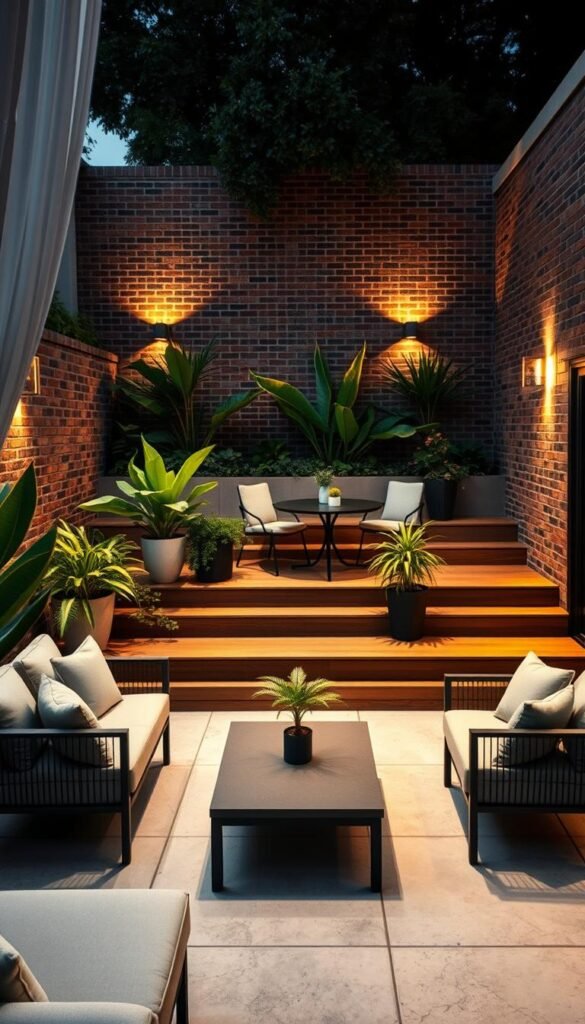
Transform your compact yard into a dynamic living space that evolves with your needs. Smart zoning turns limited square footage into a hospitality hub, productivity corner, and relaxation retreat – often within the same footprint.
Designing Multi-Use Garden Zones
Imagine a fold-down table that serves as both potting station and cocktail bar. Your fire pit could moonlight as a footrest during solo reading sessions. These adaptive solutions keep your layout fresh without permanent changes.
| Zone | Daytime Use | Evening Use |
|---|---|---|
| Patio corner | Remote office | Dinner party seating |
| Lawn strip | Yoga mat space | Outdoor cinema |
| Deck edge | Herb garden | Mood lighting display |
Use lightweight furniture on casters to shuffle layouts in minutes. A storage bench becomes extra seating when neighbors drop by. Vertical separators like bamboo screens define areas while letting breezes through.
“A well-planned zone system lets your yard grow with your life”
Layer textures through movable elements – plush outdoor rugs under metal side tables, smooth stone pavers beside gravel paths. These tactile contrasts make each functional area feel distinct yet connected.
12 Small Garden Ideas for Urban Homeowners
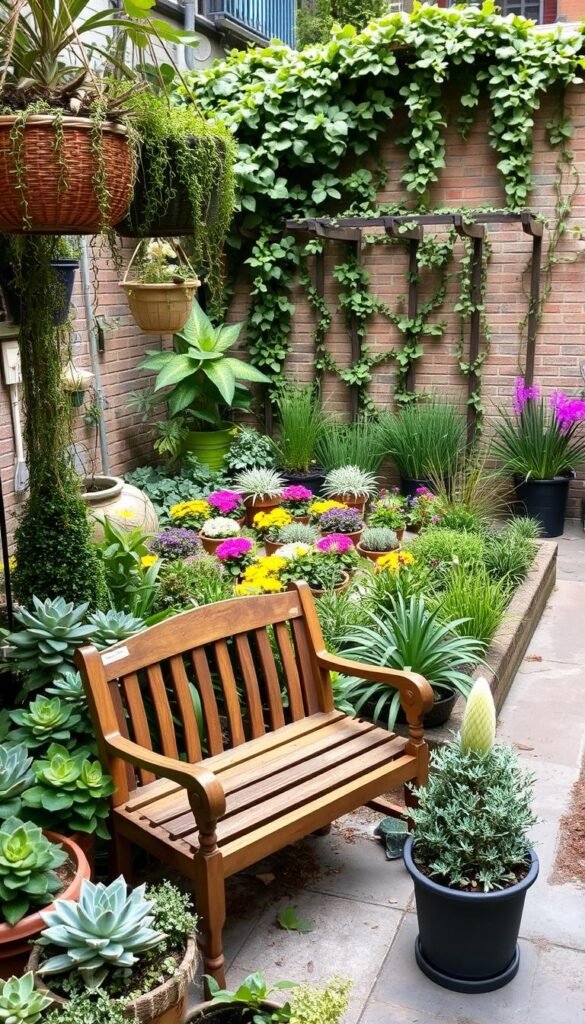
Who says limited square footage can’t spark big creativity? Discover how to reimagine your outdoor area with solutions that work smarter, not harder. From foldable furniture to edible walls, these approaches blend practicality with personality.
Vertical plant walls turn blank fences into living art galleries. Try alternating herbs like basil and thyme with trailing flowers for a fragrant display. Portable raised beds let you rotate crops or flowers seasonally – perfect for renters.
| Idea | Benefit | Pro Tip |
|---|---|---|
| Modular seating | Saves space | Add hidden storage under cushions |
| Mirror panels | Illusion of depth | Angle them to reflect greenery |
| Tiered planters | Maximizes sunlight | Group drought-tolerant species |
String lights draped overhead create cozy evenings without permanent wiring. For daytime drama, position colorful containers where sunlight hits your wall patterns. One homeowner transformed their fire escape into a succulent showcase using recycled tin cans.
“The best designs serve three purposes: beauty, function, and personal expression.”
Edible gardens thrive in unexpected places. Strawberry towers flourish in balcony corners, while compact citrus trees bear fruit in whiskey barrels. These garden ideas adapt to your lifestyle – swap out annuals for holiday decor when seasons change.
Your backyard becomes whatever you need: meditation zone, mini farmers market, or outdoor studio. Start with one project, then let success fuel your next green experiment!
Incorporating Vertical Gardening and Hanging Planters
Elevate your outdoor experience by looking upward—vertical gardening unlocks hidden potential in tight areas. Blank walls become lush tapestries when layered with foliage, while hanging arrangements add depth without crowding walkways. This approach lets you triple your planting real estate while keeping floors clear for relaxation.
Maximizing Wall and Fence Spaces
Transform dull surfaces into thriving ecosystems with these space-saving techniques:
| Method | Best For | Installation Tip |
|---|---|---|
| Modular trellises | Climbing veggies | Use rust-proof screws |
| Pocket planters | Herbs & succulents | Group by water needs |
| Living wall systems | Colorful annuals | Install drip irrigation |
Tomato vines scaling a lattice create edible privacy screens. For quick updates, mix trailing ivy with seasonal blooms in stackable planters. One Brooklyn resident grows 15 herb varieties on a 4’x6′ fence using repurposed gutters!
Utilizing Terra-Cotta and Hanging Pots
Classic clay containers offer breathability that plastic can’t match—perfect for moisture-sensitive plants like lavender. Suspend them at staggered heights to catch sunlight throughout the day. Try this eye-catching combo:
- Top tier: Purple petunias in 8″ pots
- Middle: Strawberries in hanging baskets
- Base: Rainbow chard in wide terra-cotta bowls
Rotate hanging displays monthly to maintain vibrant color. For windy spots, secure containers with marine-grade rope. As landscape architect Elena Cruz advises:
“Treat vertical surfaces as your garden’s third dimension—every square foot counts.”
Innovative DIY Garden Projects
Unleash your creativity by transforming everyday objects into stunning garden features. DIY projects let you craft unique spaces while saving money and reducing waste. Whether repurposing vintage finds or crafting temporary floral displays, these ideas blend practicality with personal style.
Upcycling Vintage Furniture
That chipped dresser gathering dust? Drill drainage holes in its drawers to create a cascading plant display. An old clawfoot tub becomes a showstopping herb garden with minimal effort—just add soil and sun-loving varieties like rosemary. These conversions add character while solving storage needs.
DIY Candle Flower Vase Ideas
Turn thrift-store candlesticks into chic flower holders. Remove wax residue, fill the cup with water, and float gardenias or miniature roses. Swap blooms weekly to match your mood or season—no digging required. As designer Jamie Durie notes:
“Temporary arrangements let you experiment risk-free. They’re the perfect way to test color schemes before committing.”
These projects develop skills you’ll use throughout your home. A weekend spent reviving a rusty chair planter teaches basic welding, while arranging vase displays sharpens your eye for composition. Best of all, every piece tells a story no store-bought item can match.
Utilizing Small-Space Furniture Solutions
Transform tight outdoor areas into welcoming retreats with furniture that works as hard as you do. A thoughtfully chosen bench becomes more than seating—it’s a stage for potted displays and afternoon conversations. Flank yours with lavender or dwarf hydrangeas to create a fragrant focal point.
Choosing the Perfect Garden Bench
Opt for slim-profile designs with hidden storage under seats. Weather-resistant teak or powder-coated metal benches withstand elements while maintaining sleek proportions. Test depth and back support—your patio should invite lingering, not squirming.
Built-In Seating for Compact Areas
Wrap seating around fire pits or dining zones to conserve space. Cushioned window boxes double as planters and impromptu perches. For inspiration on maximizing your small backyard ideas, consider foldable bistro sets that tuck against walls when unused.
Multi-level ottomans serve as footrests, side tables, or extra seats during gatherings. Your living area outdoors adapts effortlessly—stack chairs hang on hooks, while nesting tables collapse like magic. Every piece earns its place through versatility.

